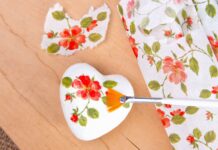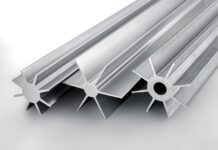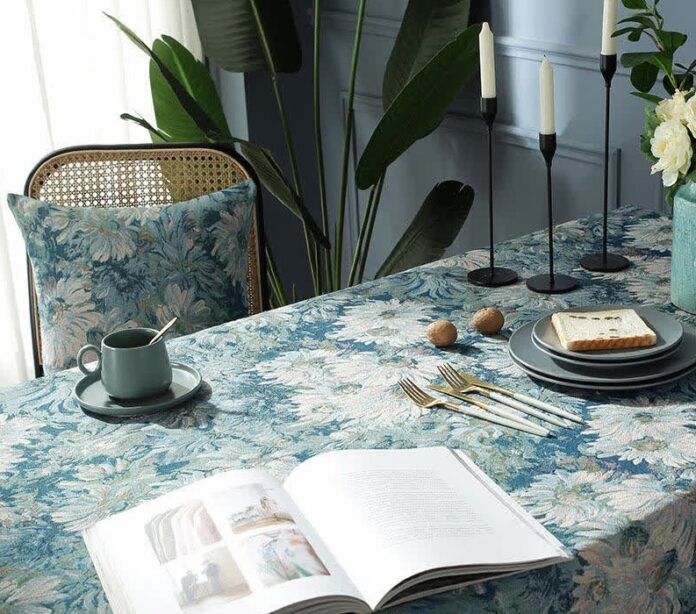
The passage discusses the importance of choosing the correct tablecloth size for enhancing dining experiences. It includes details on measuring table dimensions, understanding tablecloth drops, standard sizes for different table shapes, seasonal selection of tablecloths, material-size correlation, and care instructions for various tablecloth sizes. The right tablecloth size and care can significantly enhance the dining ambiance and prolong the tablecloth’s lifespan.
Tablecloth size is not just about aesthetics. It’s an integral aspect of setting the ambiance for any dining experience. A tablecloth that’s too short might appear untidy and can even prove inconvenient, especially if it slips off easily. On the other hand, one that drapes too long may become a tripping hazard or get caught in chair legs.
Furthermore, the right tablecloth size accentuates the beauty of your tableware, providing a harmonious backdrop that complements your dishes, glasses, and cutlery. It’s a subtle yet powerful way to make meals more inviting. When we think about celebrations, events, or even regular family dinners, the table setting plays a pivotal role, and the size of tablecloths can make or break the overall look.
Then, before choosing the ideal tablecloth size, we need to determine the size of the table, the shape of the table, the length of the tablecloth hanging from the edge of the table, the occasion where the tablecloth is used, and the material of the tablecloth.
Understanding Table Dimensions
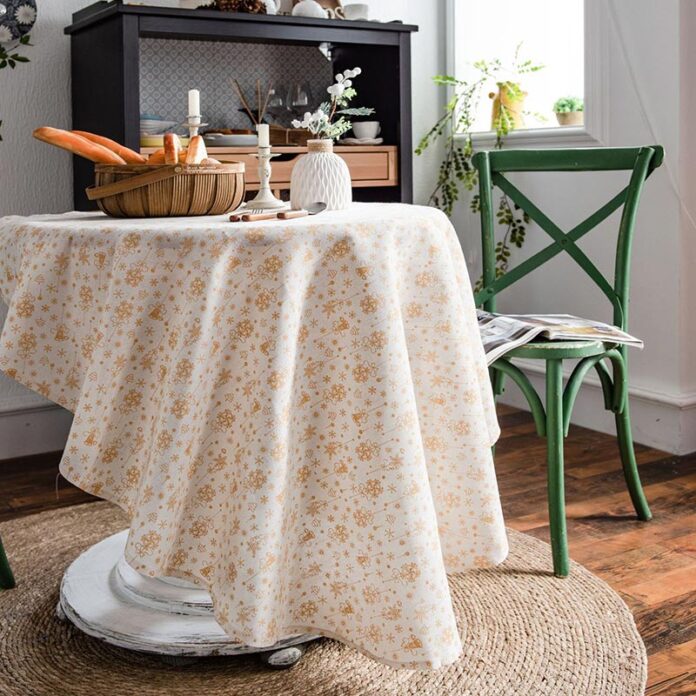
To most, a table is just a flat surface supported by legs, but delve a little deeper and you realize that its dimensions dictate its function. A long, wide table might serve as a communal dining space, fostering family gatherings and hearty meals. Conversely, a small, compact table might provide an intimate setting for a coffee chat or a workspace for an individual. It can be seen that the size of the table is very important.
When it comes to measuring table dimensions, first make sure you have a trusty tape measure or ruler. Starting at one end of the table, pull the tape measure straight across to the other end to measure the length. For width, measure from side to side. It is important to take these measurements at the widest or longest point for accuracy.
Second, we need to consider the height of the table as it determines the comfort level of the people sitting around it. A table that’s too high can make you feel like you’re reaching for your food, while a table that’s too short can cause knee and back discomfort. To measure the height, place the start of your measuring tape at the floor and extend it to the table’s topmost surface.
Tablecloth Drop ─ What is it?
The tablecloth drop is defined by the distance between the table’s surface and the point where the tablecloth ends. Typically measured in inches or centimeters, this distance can vary widely based on personal preferences and the occasion. Its importance is multifaceted.
Aesthetically, it contributes to the table’s visual appeal. The right drop can make your table setting appear cohesive, drawing attention to the centerpiece or the dishes presented. For events like weddings or dinners, you can lean towards floor-length drape for a grand, opulent feel. This style exudes luxury and formality.
In an everyday home, you can opt for a shorter drop, perhaps just a few inches beyond the edge, yet provide a more relaxed and easy-going vibe.
Functionally, longer drops can safeguard the table’s legs, but they might also be more susceptible to being pulled or tripped over. Shorter drops are often more practical for tables with frequent foot traffic around them.
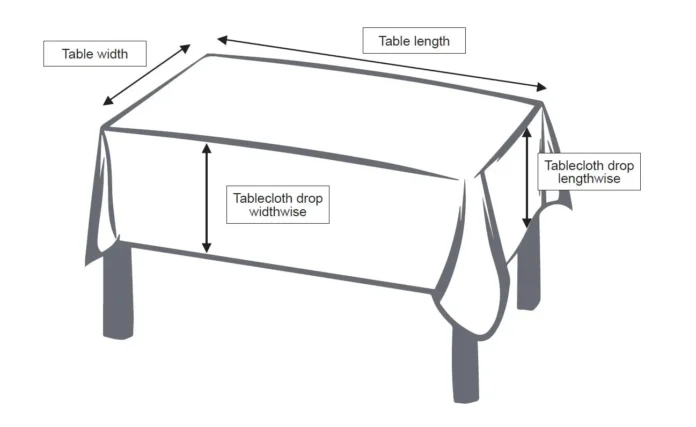
Standard Tablecloth Sizes
Rectangular tables are amongst the most popular choice for various settings, from dining rooms to conference halls. Typically, the standard dimensions for these tables start from a small size, catering to 4 people, which is approximately 48 inches in length and 30 inches in width.
Therefore, you can use a 54×54 inch tablecloth, or try a 59×157 inch tablecloth as the number of people grows. Round tables are ideal for fostering conversation, as everyone sits facing the center.
Standard diameters for round tables usually start at 36 inches, which can seat up to 4 people. Larger diameters, like 60 inches or 72 inches, can cater to 8 or 10 individuals respectively.
Seasonal Tablecloth Selection
Tablecloths of different materials and lengths can be used in different seasons, which are more suitable for scenery.
- Spring ─ Spring is a humid season, so it is not suitable to use too long tablecloths. Floral prints, pastel colors, lightweight materials, and moderate-length tablecloths are popular, echoing the rebirth and freshness of the season.
- Summer ─ It is more suitable to choose a tablecloth made of high-humidity-resistant material and with a 6-10 inch drop of tablecloths. It has tropical prints and bright colors as if you are on vacation in Hawaii in the next second.
- Autumn ─ Tablecloths transition to warmer tones. Think of golds, oranges, and deep reds, reminiscent of falling leaves. The material could also be slightly thicker and the tablecloth drop slightly longer to bring warmth to the dining experience.
- Winter ─ Tablecloths usually become heavier, longer, dark green, wine red, and may be accompanied by snowflakes, deer, and other patterns, a strong festive atmosphere.
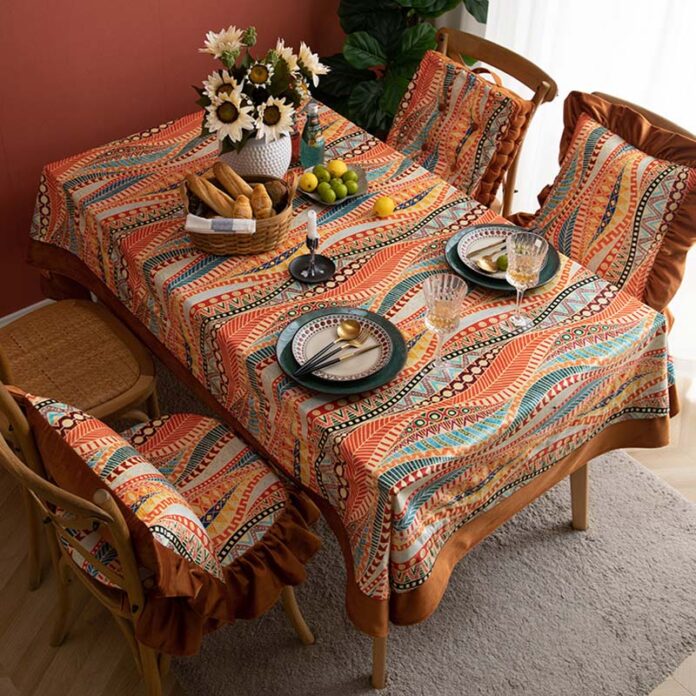
Material and Size Correlation
When choosing tablecloths, the material used plays a vital role in determining the proper size.
First, different fabrics have different weights, drapes, and textures, which can affect their fit and appearance on the table. For example, a heavy cotton tablecloth might cling to the table, showing off its shape, while a lighter silk tablecloth might be more elegant, requiring a little extra length to achieve the desired look.
Secondly, the tablecloths of some materials are extremely easy to shrink, and the size of the fabric will become smaller after washing.
Finally, when choosing a size, you also need to consider whether the material is stretchy, such as some jerseys. Stretchy tablecloths can fit the table more snugly, reducing the need for excess material.
Caring for Different-Sized Tablecloths
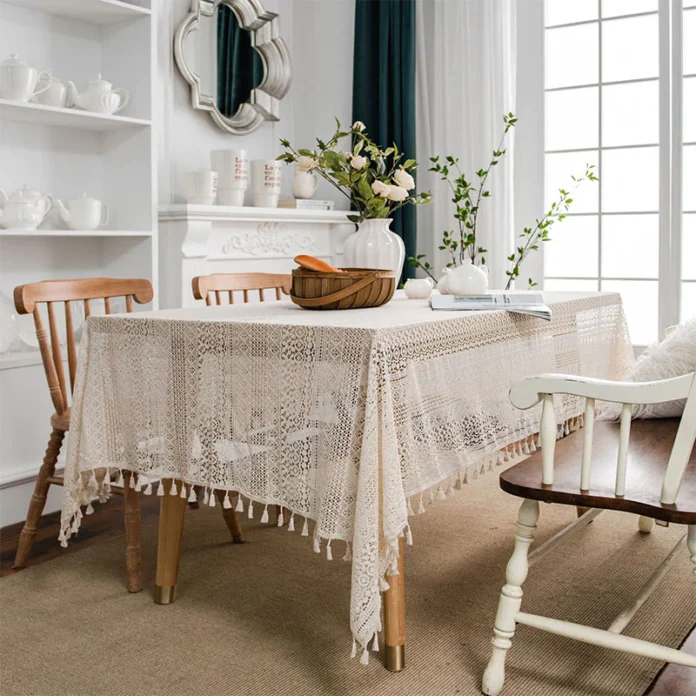
Washing Nuances
No matter the size of your tablecloth, proper care will prolong its life and keep it in pristine condition. Before storing the tablecloth, we need to wash the stains on the tablecloth.
Larger stains may not fit in standard washing machines and need to be hand washed or professionally cleaned. And larger tablecloths may require larger ironing boards or ironing in sections. They also take longer to dry and can warp if placed incorrectly. Smaller tablecloths are usually easier to manage.
Always check the care label before washing as different fabrics have different requirements. If you’re using Ownkoti‘s waterproof tablecloths, no matter the size of the tablecloth, you can just wipe up any spills or stains without frequent washing.
Storage Considerations Based on Size
Storing tablecloths correctly is essential to maintain their longevity and appearance. Large tablecloths may require more space and should be folded neatly, possibly with tissue paper between folds to prevent creasing. Rolling them around a cardboard tube can also prevent deep creases.
Smaller tablecloths can be stored in drawers or shelves but ensure they are free from moisture to prevent mold. It’s also wise to rotate which tablecloths you use regularly so that wear is evenly distributed, and no single one becomes overly worn out too quickly.
Frequently Asked Questions on Tablecloth Sizing
One of the most common concerns people have is, “How much overhang should my tablecloth have?” Typically, a drop of 8 to 12 inches is standard for casual settings, while formal events might require a longer drape.
For those with children, there’s often a worry about tablecloths being pulled off. In such cases, considering tablecloth clips or weights can be a lifesaver. If you’re in between sizes, it’s often better to go slightly larger, as you can always tuck or adjust excess fabric.
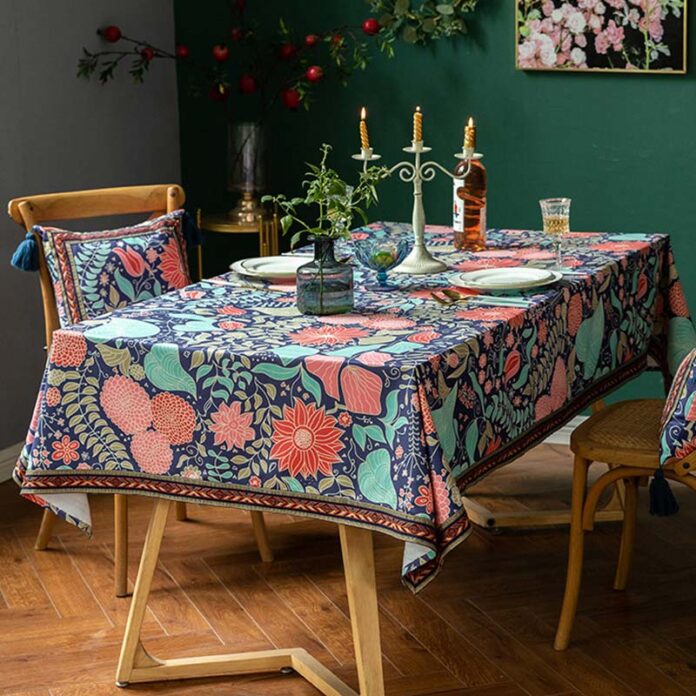
Conclusion
In the world of interior decor and dining aesthetics, tablecloths hold their unique charm. They can elevate a simple meal into a memorable occasion. With the insights shared, we hope you feel empowered and confident when shopping for tablecloths.
Remember, it’s not just about covering a table; it’s about creating an experience. With the right knowledge at your fingertips, you’re set to make decisions that resonate with your style, practical needs, and the kind of atmosphere you wish to curate.




